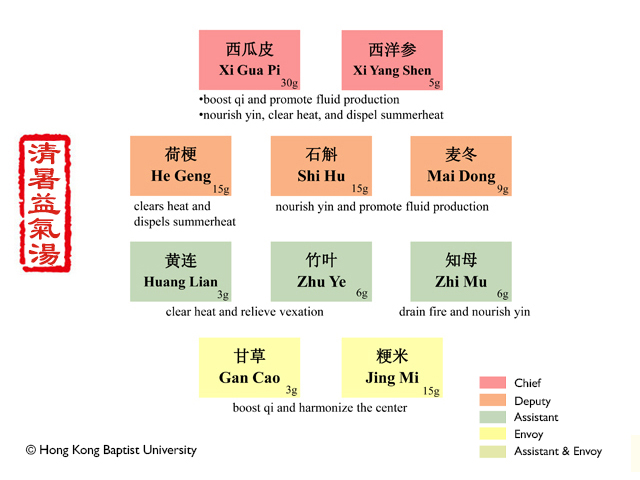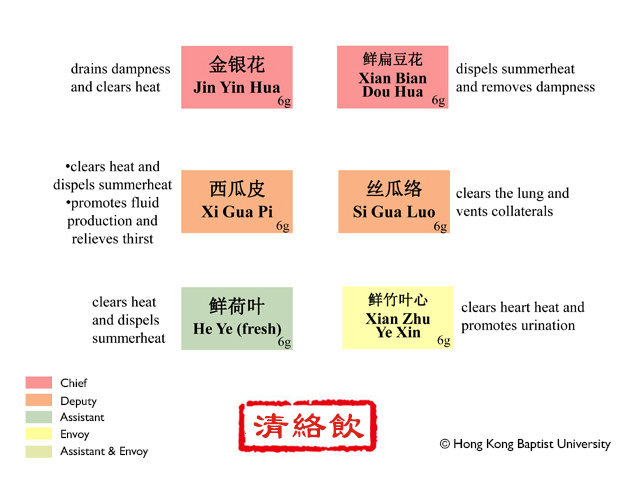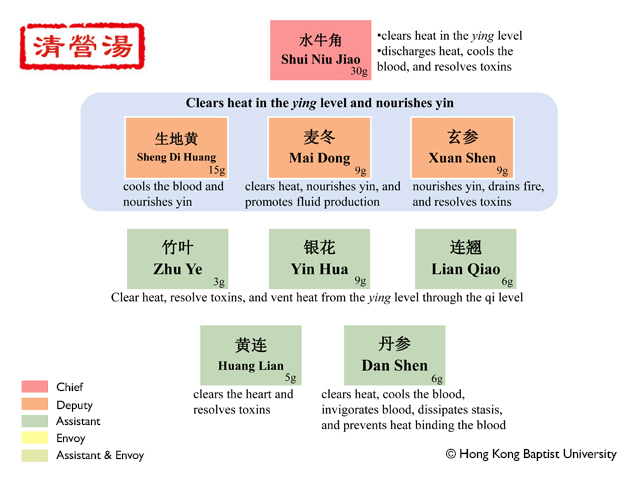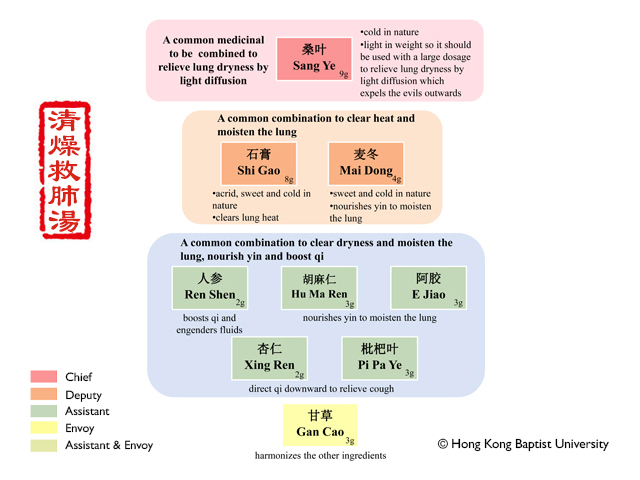| Numbering |
|
Name |
|
Combination |
|
Action |
|
Indication |
|
Thumbnail |
|
117
|
|
Summerheat-Clearing Qi-Boosting Decoction
|
|
Panacis Quinquefolii Radix; Dendrobii Caulis; Ophiopogonis Radix; Coptidis Rhizoma; Lophatheri Herba; Petiolus Nelmbinis; Anemarrhenae Rhizoma; Glycyrrhizae Radix et Rhizoma; Semen Oryza Sativa; Exocarpium Citrulli
|
|
Clears summerheat, boosts qi, nourishes yin, and generates fluids.
|
|
This formula is indicated for patterns of summerheat with damage to both qi and fluids. The symptoms are fever with profuse sweating, thirst and vexation, scanty dark urine, fatigue and weak breathing, listlessness, and a deficient, rapid pulse.
|
|

|
|
118
|
|
Channel-Clearing Beverage
|
|
Nelumbinis Folium; Lonicerae Japonicae Flos; Retinervus Luffae Fructus; Exocarpium Citrulli; Flos Lablab Album; Lophatheri Herba
|
|
Dispels summerheat and clears fire.
|
|
This formula is indicated for mild cases of summerheat with damage to the lung channel and qi level. The symptoms are moderate thirst, moderate dizziness, the feeling of moderate distention in the head, and a light red tongue body with a thin white coating.
|
|

|
|
119
|
|
Ying Level Heat-Clearing Decoction
|
|
Bubali Cornu; Rehmanniae Radix; Scrophulariae Radix; Lophatheri Herba; Ophiopogonis Radix; Salviae Miltiorrhizae Radix et Rhizoma; Coptidis Rhizoma; Lonicerae Japonicae Flos; Forsythiae Fructus
|
|
Clears heat from the ying level, resolves toxins, vents heat from the ying level, and nourishes yin.
|
|
This formula is indicated for the heat in the ying level. The symptoms are fever aggravated at night, vexation and sleeplessness, occasional delirious speech, thirst or not, inconspicuous macules and papules, crimson colored, dry tongue, and a thready, rapid pulse.
|
|

|
|
120
|
|
Eliminate Dryness and Rescue the Lung Decoction
|
|
Mori Folium; Gypsum Fibrosum; Glycyrrhizae Radix et Rhizoma; Ginseng Radix et Rhizoma; Cannabis Fructus; Asini Corii Colla; Ophiopogonis Radix; Armeniacae Semen Amarum; Eriobotryae Folium
|
|
Relieves dryness and moistens the lung, nourishes yin and boosts qi.
|
|
Qing zao jiu fei tang is indicated for the pattern of warm-dryness damaging the lung, complicated by damage to both qi and yin. The symptoms are fever, headache, coughing with no sputum, labored breathing, dryness of the nose and throat, vexation, thirst, chest fullness and hypochondriac pain. The tongue body is dry with scanty tongue coating, and the pulse is deficient, big, and rapid.
|
|

|

